Mini-implants as skeletal anchorage for impacted canine treatment: a case report
Abstract
Introduction: The maxillary canines are the most frequently retained teeth after the lower third molars. The choice of the proper moment and method of anchorage to place these teeth in the arch is underlying to reach a successful result. At present, the mini-implants use as orthodontic anchorage is a valuable choice to reach it.
Objective: To demonstrate the utility of mini-implant as skeletal anchorage unit for impacted canine treatment.
Clinical case: A thirteen-years-old female patient who has maxillary upper canines’ retention with exodontias of her first bicuspids executed. In this case, the canine was retained by palatal and it was impacting to distal surface of the lateral maxillary right incisor. The mini-implant was placed between vestibular roots of the maxillary first molar; it is an infrequent insertion place. Finally, canine was de-impacted and carried to the arch by traction through usual procedures.
Conclusions: A late diagnosis of impacted canines requires a multidisciplinary management that includes surgical and orthodontic techniques; it increases the complication possibilities during their treatment. The obtained results by this study corroborate that skeletal anchorage is able to reduce the treatment time, because the retained canine was de-impacted in just two months. Mini-implants’ use requires anatomy, physiology, biomechanics, growth and development, osseous architecture knowledge to warrant a successful result. Mini-implants represent a new and useful option, as skeletal anchorage unit, in the impacted canines’ treatment. The mini-implant was successfully placed between vestibular roots of the maxillary first molar, and it got de-impacted quickly and without complications.
DeCS: DENTAL IMPLANTS; ORTHODONTIC ANCHORAGE PROCEDURES; CUSPID/ abnormalities; CUSPID/ growth & development; ADOLESCENT.
Downloads
References
2. García López JE, Palmas OS. Tracción ortodóncica de caninos maxilares impactados. Revisión de Literatura. MQRInvestigar [Internet]. 2023 [citado 15 Ago 2023]; 7(1): 2838-56. Disponible en: http://www.investigarmqr.com/ojs/index.php/mqr/article/view/295
3. Graber DLW, Vanarsdall RL, Vig KW, Huang GJ. Ortodoncia: principios y técnicas actuales. Elsevier Health Sciences [Internet]. 2019 [citado 15 Ago 2023]:744. Disponible en: https://books.google.es/books?hl=es&lr=&id=pltgDwAAQBAJ&oi=fnd&pg=PP1&dq=diferentes+t%C3%A9cnicas+de+ortodoncia&ots=wT5eR_1wns&sig=sVOMxKYBxyMTGumozwiRwqnQFr8#v=onepage&q=diferentes%20t%C3%A9cnicas%20de%20ortodoncia&f=false
4. Chinchurreta F, Bono AE, Macluf Filho E. Anclaje esquelético para el tratamiento de las anomalías de clase II y mordida abierta anterior. Informe de un caso. Revista de la Sociedad Odontológica de La Plata [Internet]. 2021 [citado 15 Ago 2023]; 31(61):23-29. Disponible en: https://web.s.ebscohost.com/abstract?direct=true&profile=ehost&scope=site&authtype=crawler&jrnl=15149943&AN=155770968&h=Cn6ia1ljJusToU8%2bIW5Ep0U%2b24kP8eNx%2bIpMd5DSJbAVpFXujnK9fCskwuVv37oYdmes7Y%2bDunNozsp4qqZZeQ%3d%3d&crl=c&resultNs=AdminWebAuth&resultLocal=ErrCrlNotAuth&crlhashurl=login.aspx%3fdirect%3dtrue%26profile%3dehost%26scope%3dsite%26authtype%3dcrawler%26jrnl%3d15149943%26AN%3d155770968
5. Rosero Flores LY, Santamaría Peña EM, Salame Ortiz VA. Tratamientos de ortodoncia a través de micro-implantes. Revista Dilemas Contemporáneos: Educación, Política y Valores [Internet]. 2023 [citado 15 Ago 2023]; 2(83). Disponible en:
https://dilemascontemporaneoseducacionpoliticayvalores.com/index.php/dilemas/article/view/3556/3508
6. Gil Ramos LV, Maestre Polanco VA, Herrera Herrera A, Rebolledo Cobos M. Factores que inciden sobre el éxito y/o fracaso de mini-implantes en ortodoncia: una revisión sistemática exploratoria. Duazary [Internet]. 2022 [citado 15 Ago 2023]; 19(3): 229-42. Disponible en: https://revistas.unimagdalena.edu.co/index.php/duazary/article/view/4839
7. Durán F, Hormazábal F, Toledo X, Chang RH, González N, Sciaraffia P. Una descripción general y actualizada de miniplacas y minitornillos. Efectos dentoalveolares y esqueléticos. Int J Odontostomat [Internet]. 2020 [citado 15 Ago 2023]; 14(1). Disponible en: https://scielo.conicyt.cl/scielo.php?script=sci_arttext&pid=S0718-381X2020000100136&nrm=iso
8. Gómez R. Manejo periodontal de los caninos impactados por el paladar. Contacto científico [Internet]. 2022 [citado 15 Ago 2023]; 2(1):8-19. Disponible en: https://revistas.up.ac.pa/index.php/contacto_cientifico/article/view/3276
9. Chamaidan Moreno A. Inclusión de caninos y su abordaje ortoquirúrgico [Internet]. Ecuador: Universidad de Guayaquil; 2022 [citado 2023 Ago 15]. Disponible en: http://repositorio.ug.edu.ec/handle/redug/62654
10. León Puzma MF, Zapata Hidalgo CD. Consideraciones radiográficas para la colocación de mini-implantes. Revista Metropolitana de Ciencias Aplicadas [Internet]. 2023 [citado 15 Ago 2023]; 6. Disponible en: http://remca.umet.edu.ec/index.php/REMCA/article/view/651













